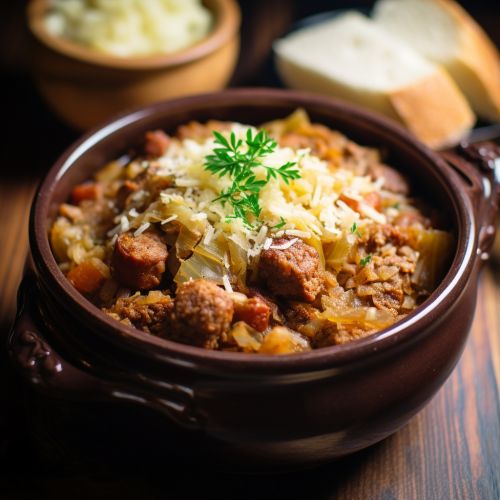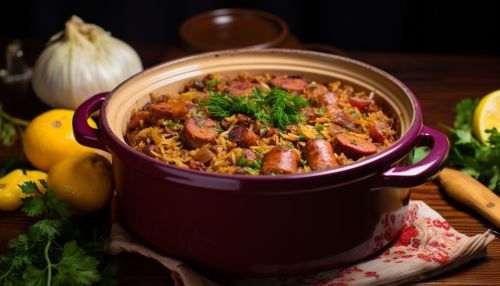Bigos
Introduction
Bigos is a traditional stew typical of Polish and Lithuanian cuisines. The dish, often referred to as a "hunter's stew," is a hearty mixture of various meats, sausages, and vegetables, with the key ingredient being shredded cabbage or sauerkraut. Bigos is characterized by its rich flavor, which is enhanced through long, slow cooking. The dish's origins can be traced back to medieval times, making it one of the oldest and most traditional dishes in Central and Eastern Europe.


History
The history of bigos stretches back to the Middle Ages, when it was a popular dish among the nobility in Poland and Lithuania. The name "bigos" is derived from the German word "bigosch," which means "to mix." This is a fitting description of the dish, as it is a mix of various ingredients, each contributing to the overall flavor and texture of the stew.
The dish was originally prepared by hunters, who would add the game they caught to a pot of simmering cabbage. Over time, the recipe evolved, with different regions adding their own local ingredients and variations. Despite these changes, the core elements of the dish - meat, sausages, and cabbage - have remained the same.
Ingredients
The ingredients used in bigos can vary greatly, depending on the region and personal preference. However, there are several key ingredients that are typically included in the dish:
- Meat: A variety of meats can be used in bigos, including pork, beef, chicken, and game. The meat is usually cut into small pieces and browned before being added to the stew.
- Sausages: Various types of sausages are also added to the stew, contributing to its rich, hearty flavor. These can include kielbasa, a type of Polish sausage, as well as other smoked or cured sausages.
- Cabbage: Shredded cabbage or sauerkraut is a key ingredient in bigos. It is often simmered for a long time, until it becomes soft and tender.
- Vegetables: Other vegetables, such as carrots, onions, and mushrooms, are also commonly added to the stew.
- Spices: Bigos is typically seasoned with a variety of spices, including bay leaves, peppercorns, and caraway seeds. Some recipes also include a splash of wine or beer for added flavor.
Preparation
The preparation of bigos involves several steps, each contributing to the development of the stew's complex flavors. The process begins with the browning of the meats and sausages, which are then set aside. The cabbage is then simmered in a large pot, along with the other vegetables and spices.
Once the cabbage is tender, the browned meats and sausages are added back into the pot. The stew is then left to simmer for several hours, allowing the flavors to meld together. Some recipes recommend letting the stew sit overnight and reheating it the next day, as this can further enhance the flavors.
Cultural Significance
Bigos is more than just a dish in Poland and Lithuania - it is a symbol of national identity and a staple at celebrations and gatherings. It is traditionally served during Christmas and Easter, as well as at weddings and other festive occasions. The dish is often prepared in large quantities and shared among family and friends.
In addition to its role in traditional celebrations, bigos is also a popular everyday dish. It is commonly served in homes and restaurants across the country, and is a favorite comfort food during the cold winter months.
Variations
While the basic recipe for bigos remains the same, there are many regional variations of the dish. In some areas, game meat is used instead of pork or beef, reflecting the dish's origins as a hunter's stew. Other variations may include the addition of other vegetables, such as potatoes or bell peppers, or different types of sausages.
Despite these variations, the essence of bigos - a hearty, flavorful stew of meats, sausages, and cabbage - remains the same. This consistency is a testament to the enduring popularity of the dish and its deep roots in Polish and Lithuanian culture.
